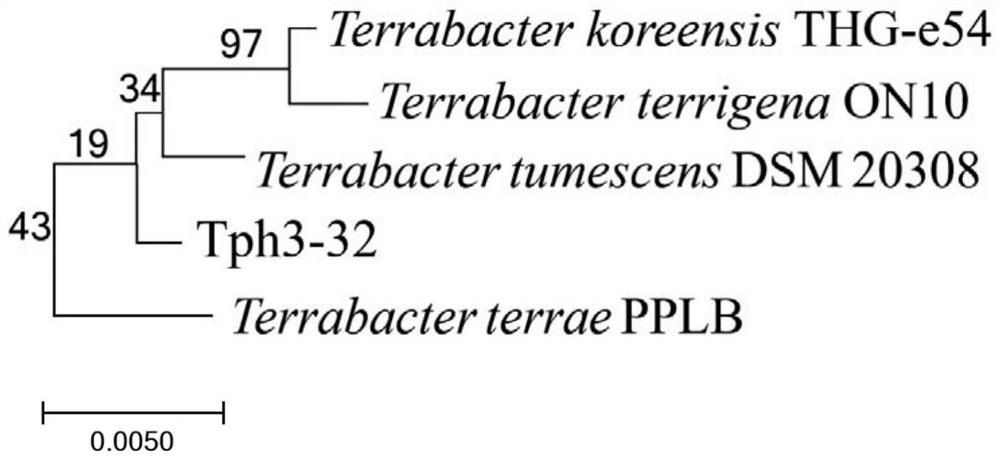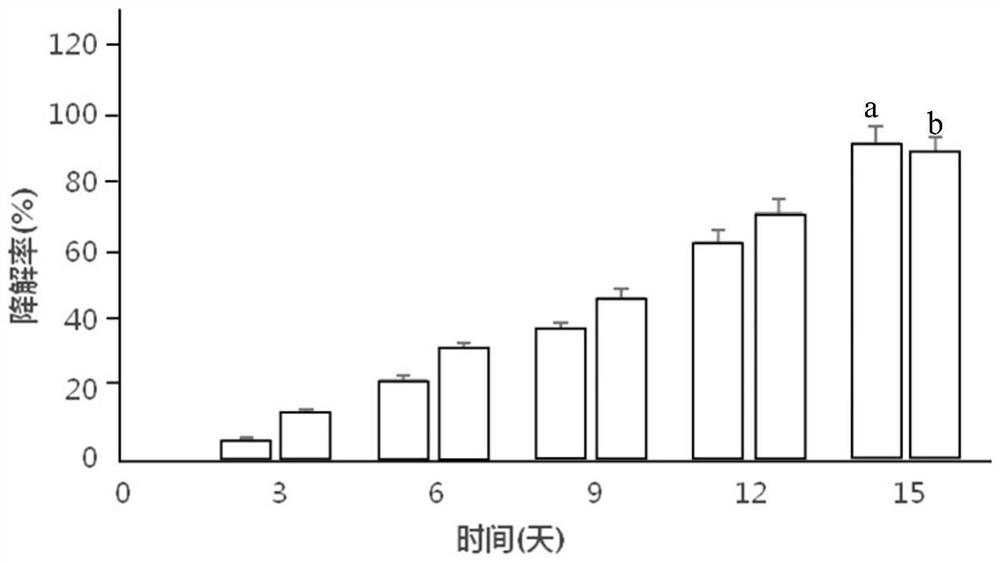A Chromium-resistant Petroleum Hydrocarbon Degrading Strain tph3-32 and Its Application
A petroleum hydrocarbon and chromium-resistant technology, applied to the petroleum hydrocarbon degrading strain Tph3-32 and its application field, can solve the problems of uncontrollable risk, high cost, long cycle, etc., and achieve rich strain resources, great research value and application prospect Effect
- Summary
- Abstract
- Description
- Claims
- Application Information
AI Technical Summary
Problems solved by technology
Method used
Image
Examples
Embodiment 1
[0017] Example 1: Morphological characteristics of petroleum hydrocarbon degradation strain (Terrabacter sp.) Tph3-32
[0018] Streak inoculate a single colony into LB solid medium, place the plate upside down in a constant temperature incubator, and incubate at 28°C for 72h. Gram staining of the bacterium was positive, the biological characteristics were non-fermentative, obligate aerobic, and the bacterium was non-bacillus. It is round, off-white and translucent, with smooth and moist surface, regular edges, no halo, raised center, 0.7-1.2mm in diameter.
Embodiment 2
[0019] Example 2: Screening and Identification of Petroleum Hydrocarbon Degrading Strain (Terrabacter sp.) Tph3-32
[0020] (1) On-site collection of soil samples about 5cm below the surface of the petroleum hydrocarbon polluted area (E113°55′, N22°20′) of the Macao Power Plant, after preliminary removal of impurities such as grass roots and stones, sent to the laboratory at low temperature as the next step One-stage screening of sample sources for functional strains.
[0021] (2) Under laboratory conditions: take a 250mL Erlenmeyer flask, wash it, fill it with 90mL deionized water and add 25 glass beads with a diameter of 0.5cm, seal it, and autoclave it at 121°C for 20min. After the system cooled down to room temperature, put 10.0 g of the aforementioned soil samples into the Erlenmeyer flask in the ultra-clean workbench, re-seal it, and shake it in a constant temperature shaker at 28°C for about 30 minutes to fully release the microorganisms in the soil pores. The suspensi...
Embodiment 3
[0023] Embodiment 3: Petroleum hydrocarbon degradation bacterial strain (Terrabacter sp.) Tph3-32 is to Cr 6+ and Determination of Diesel Degradation Rate
[0024] (1) Prepare LB liquid medium, and pick a single colony of petroleum hydrocarbon degrading strain (Terrabactersp.) Tph3-32 on the LB solid plate, inoculate it in LB liquid medium, and cultivate it overnight, which is Tph3-32 seed solution . After sterilizing 10g of crude oil and 90mL of inorganic salt liquid medium, mix them under aseptic conditions, and add potassium dichromate powder dried to constant weight to make the Cr in the system 6+ It is 150mg / L (the value is determined by the preliminary experiment). Inject the strain seed liquid at a ratio of 1%, cultivate at 28°C and 150rpm for 15 days, take samples every 3 days, and measure Cr 6+ and the content of crude oil, and calculate the degradation rate at the corresponding time point.
[0025] (2) The results showed that the petroleum hydrocarbon degrading s...
PUM
| Property | Measurement | Unit |
|---|---|---|
| diameter | aaaaa | aaaaa |
Abstract
Description
Claims
Application Information
 Login to View More
Login to View More - R&D
- Intellectual Property
- Life Sciences
- Materials
- Tech Scout
- Unparalleled Data Quality
- Higher Quality Content
- 60% Fewer Hallucinations
Browse by: Latest US Patents, China's latest patents, Technical Efficacy Thesaurus, Application Domain, Technology Topic, Popular Technical Reports.
© 2025 PatSnap. All rights reserved.Legal|Privacy policy|Modern Slavery Act Transparency Statement|Sitemap|About US| Contact US: help@patsnap.com


